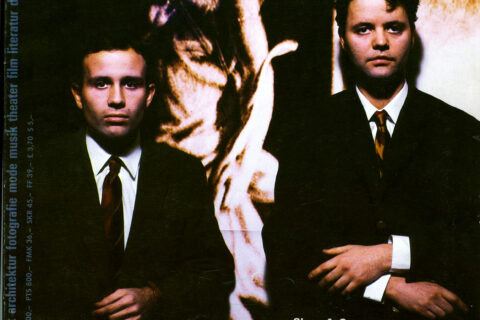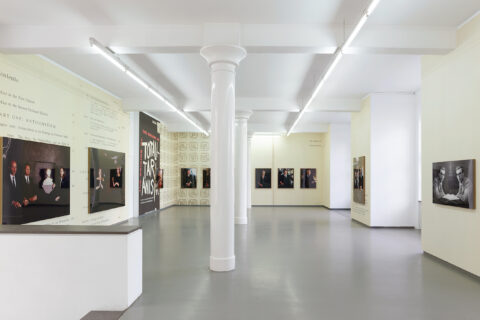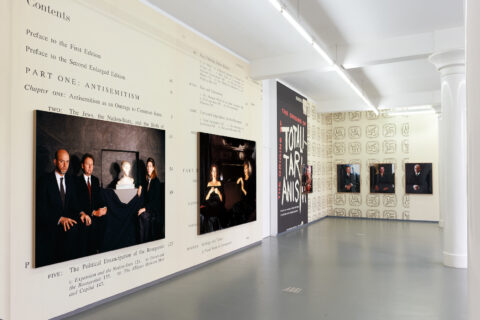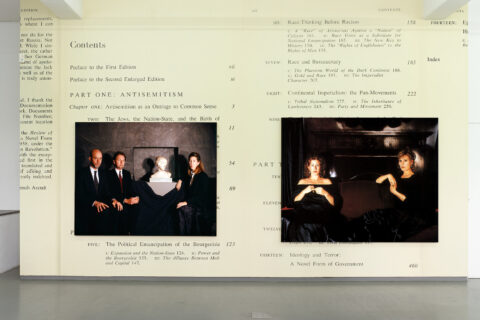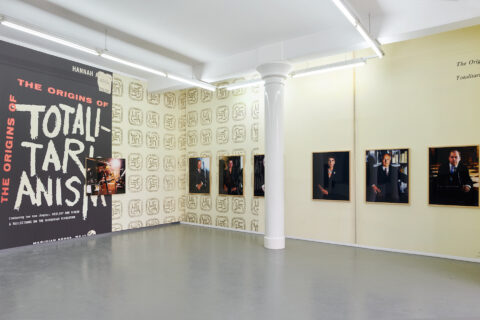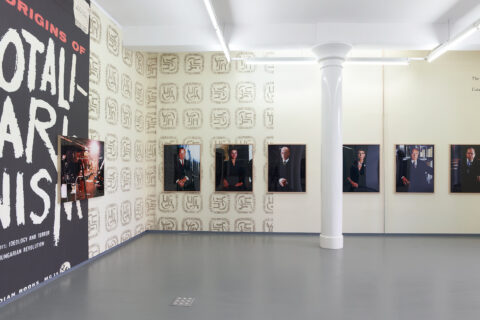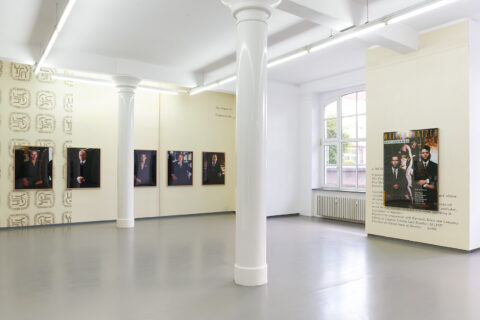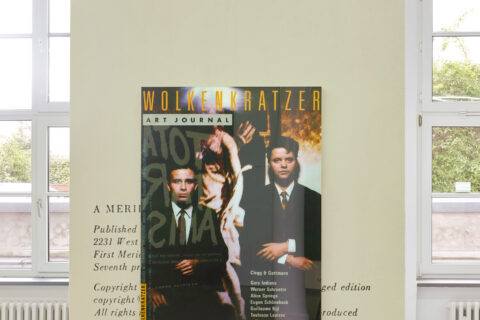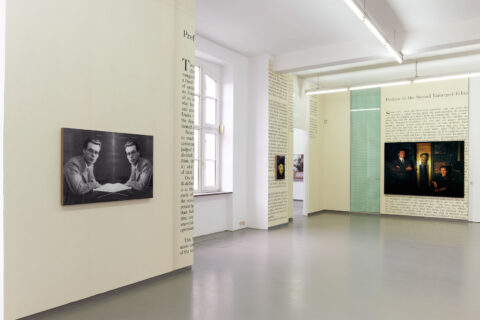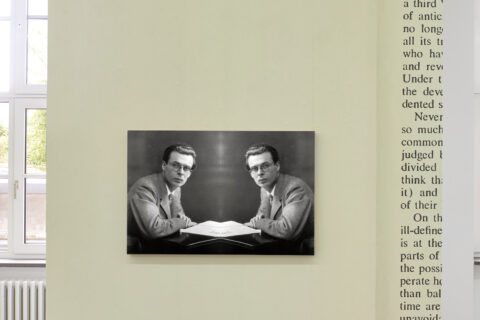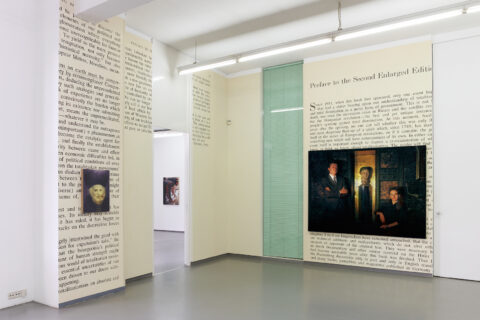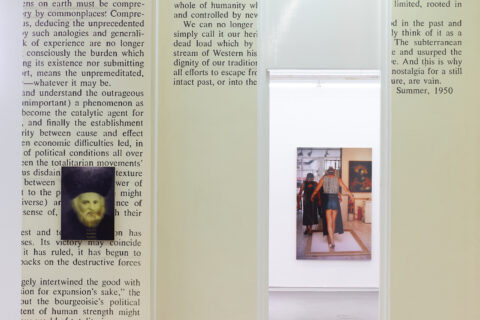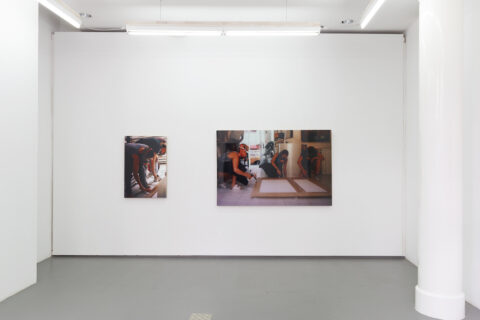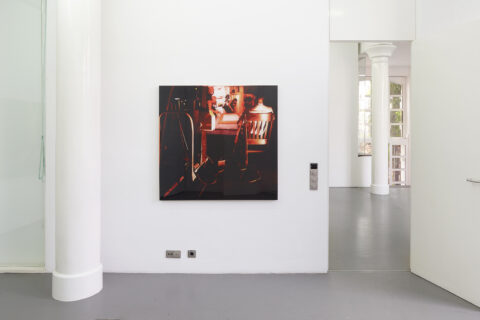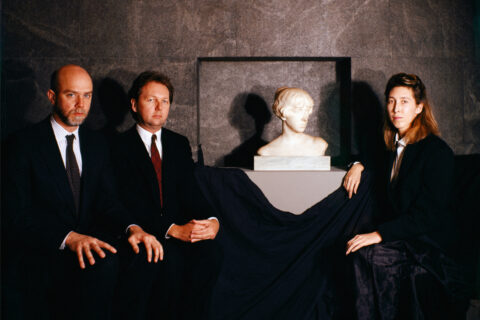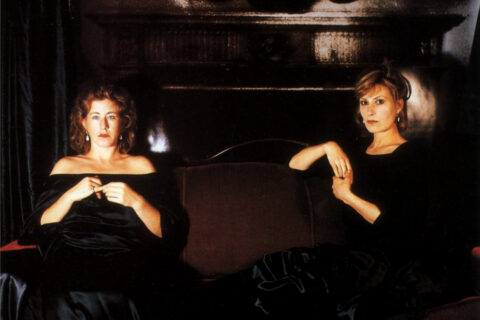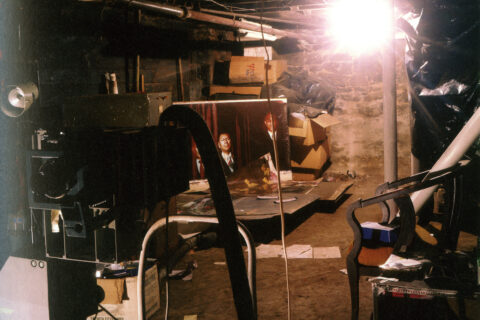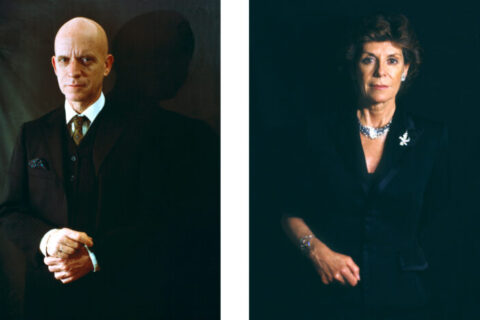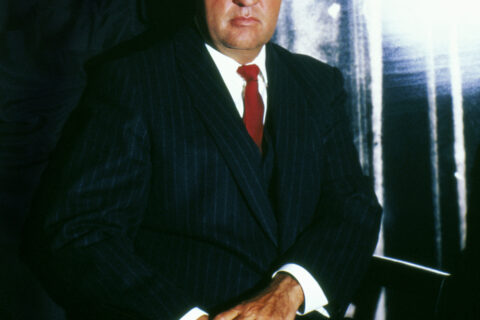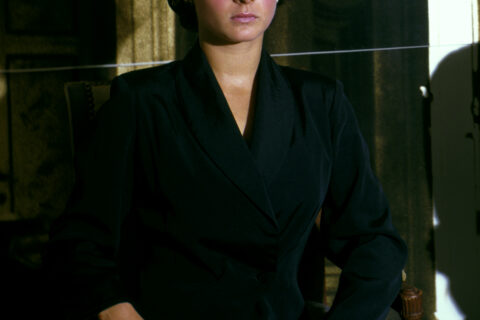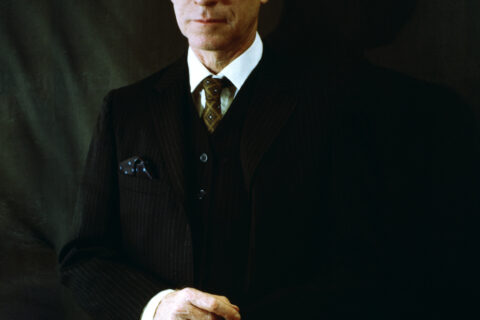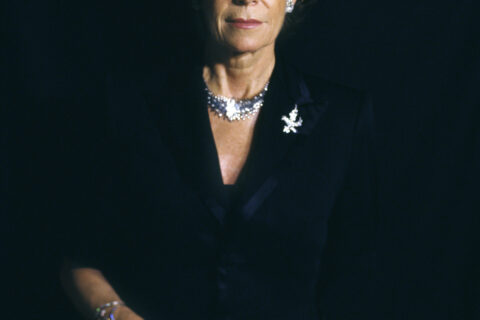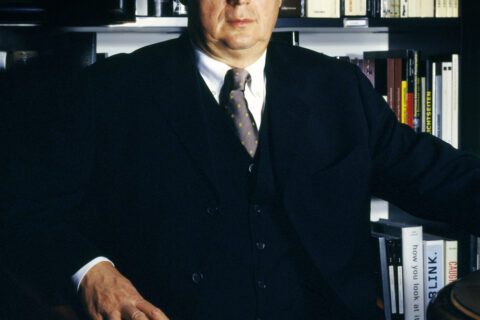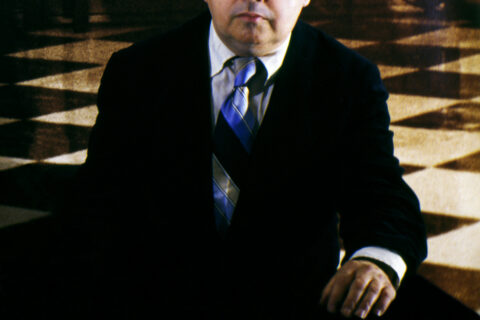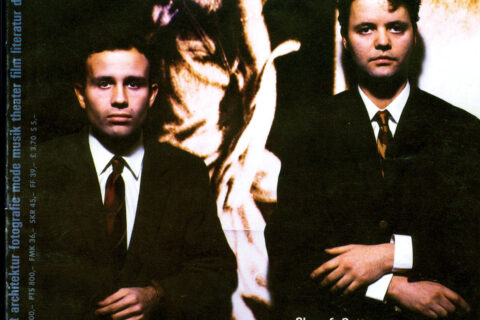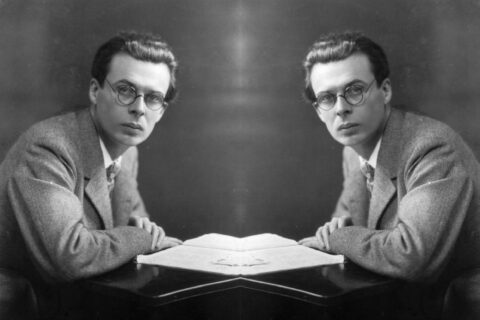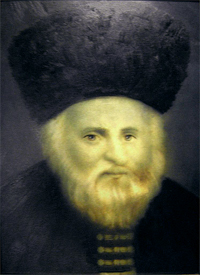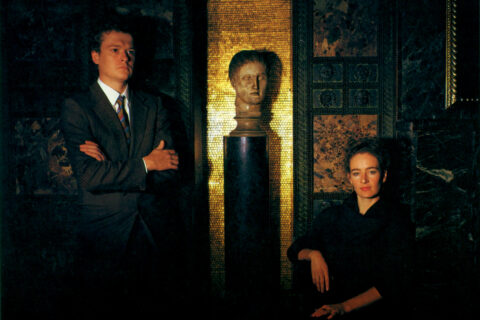Clegg & Guttmann Eye Contact: The Origins of Totalitarianism
25/04/2017 – 17/05/2017
Eröffnung: Sonntag, 23. April 2017, 15-18 Uhr
Opening: Sunday, April 23rd, 2017, 3-6 pm
Galerie Nagel Draxler
Bismarckstraße 50 / Hinterhof
50672 Köln
Öffnungszeiten / Hours:
Di–Fr: 11 – 18 Uhr / Tue–Fri: 11 am – 6 pm
Sa: 11 – 16 Uhr / Sat: 11 am – 4 pm
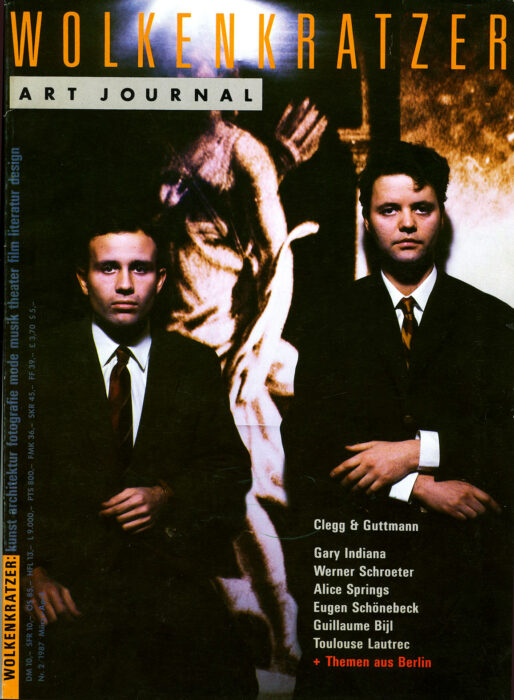
„Eye Contact: The Origins of Totalitarianism“, 2017
Installationsansicht
Galerie Nagel Draxler, Köln
Photo: Simon Vogel
„Eye Contact: The Origins of Totalitarianism“, 2017
Installationsansicht
Galerie Nagel Draxler, Köln
Photo: Simon Vogel
„Eye Contact: The Origins of Totalitarianism“, 2017
Installationsansicht
Galerie Nagel Draxler, Köln
Photo: Simon Vogel
„Eye Contact: The Origins of Totalitarianism“, 2017
Installationsansicht
Galerie Nagel Draxler, Köln
Photo: Simon Vogel
„Eye Contact: The Origins of Totalitarianism“, 2017
Installationsansicht
Galerie Nagel Draxler, Köln
Photo: Simon Vogel
„Eye Contact: The Origins of Totalitarianism“, 2017
Installationsansicht
Galerie Nagel Draxler, Köln
Photo: Simon Vogel
„Eye Contact: The Origins of Totalitarianism“, 2017
Installationsansicht
Galerie Nagel Draxler, Köln
Photo: Simon Vogel
„Eye Contact: The Origins of Totalitarianism“, 2017
Installationsansicht
Galerie Nagel Draxler, Köln
Photo: Simon Vogel
„Eye Contact: The Origins of Totalitarianism“, 2017
Installationsansicht
Galerie Nagel Draxler, Köln
Photo: Simon Vogel
„Eye Contact: The Origins of Totalitarianism“, 2017
Installationsansicht
Galerie Nagel Draxler, Köln
Photo: Simon Vogel
„Eye Contact: The Origins of Totalitarianism“, 2017
Installationsansicht
Galerie Nagel Draxler, Köln
Photo: Simon Vogel
„Printing and Framing (2), 1991
Lamdba print mounted on aluminium, plexiglass, MDF-frame
84,5 x 120 cm
Edition: 1/3
„Printing and Framing (3)“, 1991
Lambda print mounted on aluminium, plexiglass, MDF-frame
178 x 118,5 cm
Edition: 1/3
Photo: Simon Vogel
„Printing and Framing (4)“, 1991
Lambda print mounted on aluminium, plexiglass, MDF-frame
94 x 64 cm
Edition: 1/3
„Printing and Framing (5)“, 1991
Lambda print mounted on aluminium, plexiglass, MDF-frame
115 x 176,5 cm
Edition: 1/3
Photo: Simon Vogel
„Printing and Framing (6)“, 1991
Lambda print mounted on aluminium, plexiglass, MDF-frame
124 x 120,5 cm
Edition: 1/3
Photo: Simon Vogel
„The Curators of the Whitney Biennial“, 2013 (1987)
Lambda print mounted on aluminium, plexiglass, MDF-frame
155,5 x 194 cm
Version 2 of 3 unique versions
„The Gallery Proprietresses“, 1986
Lambda print mounted on aluminium, plexiglass, MDF-frame
170 x 214 cm
Version 2 of 3 unique versions
„Printing and Framing (1)“, 1991
Cibachrome print mounted on aluminium, plexiglass, MDF-frame
86,5 x 107 cm
Edition: 1/3
„Gazes of Decreasing Intensity (1-6)“, 2017
Lambda print mounted on aluminium, plexiglass, MDF-frame
each 103 x 83 cm (framed)
„Gazes of Decreasing Intensity (1)“, 2017
Lambda print mounted on aluminium, plexiglass, MDF-frame
103 x 83 cm (framed)
„Gazes of Decreasing Intensity (2)“, 2017
Lambda print mounted on aluminium, plexiglass, MDF-frame
103 x 83 cm (framed)
„Gazes of Decreasing Intensity (3)“, 2017
Lambda print mounted on aluminium, plexiglass, MDF-frame
103 x 83 cm (framed)
„Gazes of Decreasing Intensity (4)“, 2017
Lambda print mounted on aluminium, plexiglass, MDF-frame
103 x 83 cm (framed)
„Gazes of Decreasing Intensity (5)“, 2017
Lambda print mounted on aluminium, plexiglass, MDF-frame
103 x 83 cm (framed)
„Gazes of Decreasing Intensity (6)“, 2017
Lambda print mounted on aluminium, plexiglass, MDF-frame
103 x 83 cm (framed)
„Our Production/The Production of Others (Wolkenkratzer, 1987)“, 2017
Lambda print mounted on aluminium, plexiglass, MDF-frame
146 x 107 cm
„The Ultimate Revolution“, 2017
Lambda print, mounted on aluminium, plexiglass, MDF-frame
74 x 112 cm
Edition: 1/3
„The Genius of Vilnius“, 2017
Lambda print, mounted on aluminium, plexiglass, MDF-frame
55,2 cm x 40 cm
Edition: 1/3
„Artist and Models“, 1986
Lambda print mounted on aluminium, plexiglass, MDF-frame
150 x 200 cm
Version 2 of 3 unique versions
Press Release
Eye Contact: The Origins of Totalitarianism
Clegg & Guttmann
Cologne, 2017
Part One: The Origins of Totalitarianism
The New political context
Q: The Origins of Totalitarianism by Hannah Arendt covers the gallery walls and your artworks are hung on top. What made you decide to do that?
A: When we wallpapered the gallery with The Origins of Totalitarianism we (literally) made its political content part of the context of the artworks in the exhibition. The present political condition is anything but business as usual; the world-order that had emerged after WWII in virtue of which peace reigned in Europe for 70 years is threatened by a new breed of rightist politicians in a number of countries– by Trump in US; by Farage and other Brexiters; Marine Le Pen in France, the Alternative for Germany, Wilders in Holland, etc. These new challenges joined older ones like Putin’s and Erdogan’s authoritarianism; the totalitarian regime in communist China; the populists in Hungary and Poland; Khameni in Iran etc.
These threats to liberal democracy and the post-war order created together a new political context that impacts anything produced today including the present exhibition. The wallpapered gallery emphasizes the importance of the new political context and its strong influence over the meaning of the artworks in the exhibition.
Q: Why did you choose The Origins of Totalitarianism?
A: The Origins was published in 1951 – not long after the end of WWII. The book contained an extraordinarily lucid analysis of the totalitarian ideology of the 1930’s that ignited the war. Many of the theses in Arendt’s book were forgotten for a while; now that we are faced with a new wave of authoritarian impulses, they should be discussed once more.
Q: Can you give an example?
A: One invaluable insight concerns the relations between Fascism and Nationalism; Arendt maintained that the widespread tendency to equate the two rested on a mistake.
Q: Why?
A: The fascists, according to Arendt, employed nationalist terminology in a cynical way to appeal to conservative voters. The real Nazis never accepted the limitations of the national matrix; they knew that they were part of an international movement not unlike bolshevism. Today, we witness the emergence of a new international right-wing movement. We see how Trump and Farage, for example, regard each other as brothers in arms; Putin is a hero for both of them whereas Merkel is their common enemy.
Q: Does Arendt elucidate the new ideology of the right?
A: Arendt argued that the fascists are right wing revolutionaries rather than reactionaries. The old-school nationalists had the highest respect for traditional values – they wanted to preserve the status quo; the fascists on the other hand had nothing but contempt for past traditions.
Q: Does that apply today as well?
A: The right wing that emerges nowadays is an anti-establishment movement that has no wish to preserve past traditions either. On the contrary - their rallying cry is “drain the swamp!” - destroy the entire political establishment.
Q: Did Reagan belong to that type of right wing?
A: The short answer is no. Reagan’s was a ‘small government’ right wing – he was the original neo-liberal. Arguably, Trump marks the end of neo-liberalism; he is an economic populist; he promises to take care of the ‘forgotten’ working class; he promotes infra-structural projects neo-liberals loath to accept. To some extent, I believe he is sincere.
Q: What about Trump’s foreign policies?
A: The neo-liberal secret ideal is a ‘world government’ led by the big corporations – a project that requires a veneer of global harmony. Trump does not accept any of it; like the strongmen of the 1930’s, he wants to dominate big business; his style is provoking confrontations – not very business-like; moreover, he believes that human affairs are always dominated by conflict and war. That is also where the difference between the fascists and the nationalists lies – both do not hesitate to enter into conflicts to defend the national interest but the fascists regard war as the natural condition of mankind that brings the best in people.
The Hungarian revolution
Q: The text on the wallpaper is the second edition of Origins; why is that?
A: In the second edition of 1958 Arendt added a new chapter about the Hungarian revolution. The revolution was a watershed moment – millions left the communist party in 1956; these were loyal communists who remained in the party despite the revelations after Stalin’s death about his reign of terror; they regarded the bloody repression of the Hungarians as final proof of the inherent evil of the Soviet regime. For Arendt, the Hungarian bloodbath provided the ultimate demonstration of the main claim of the book, namely, that National Socialism and Stalinism were different variants of totalitarianism. Arendt implied that the American system was not void of totalitarian facets either.
Q: The text on the walls of the gallery is an enlargement of a pdf of a scanned library book from UCLA that you found on the Net. Can you explain why you chose that particular source?
A: Apart from providing the viewers with philosophical insights about the present political situation, we wanted the installation to conjure up the historical moment when Hannah Arendt’s book entered the mainstream discourse. The fact that the text we used came from UCLA’s library is highly important in that respect: The University of California – both Berkeley and UCLA – played a very important role in the radicalization of American youth during the sixties. Putting on the gallery walls the actual text of Arendt that the young radicals of UCLA read in the 60’s, adds another layer of history.
Q: You insisted on enlarging the pdf without any changes; you included even the blank pages!
A: We encountered the pdf of the Origins on the Net by chance; very quickly, though, we realized it was a treasure trove of highly significant concrete historical details. Take the cover for example – the fact that the title of a book on political science had ‘abstract expressionist’ typography was unexpected and delightful. Another group of interesting graphic details are the watermarks - the UCLA librarians probably added them. Even the empty pages are significant – they are part of an old-school book design that immediately sends a whiff of the 1950’s. We wanted the viewer to have a concrete sense of the arc that began when Arendt immigrated to the US and started teaching in the New School for Social Research and ended in the pdf of her book found on the Net. Indeed, the ‘media archaeology’ of the pdf itself was fascinating: The enlarged dot-matrix pattern places you in the post-WWII world; the pixels introduce the contemporary part of the historical arc. The superposition of both - the ‘pixelated dot matrix pattern’ – encapsulates the passage from the 1950’s, when the book came out, to the present.
Part Two: Eye contact
Commissioned and Generic portraits
Q: The second theme of the exhibition is the concept of eye contact. You claim that radical social transformations like the one we are experiencing today alter the way people look at each other. In your view, the change impacts a wide variety of cases - even the eye contact with portraits. Do you think that every portrait is affected by these socio-political changes including yours?
A: The first question to ask is what type of portraits would be most affected by changes in the way real people make eye contact. Before we answer, let us recall the standard distinction between commissioned portraits and generic ones – those representing specific individuals versus others depicting a social category or a type. The distinction does not only concern the biographical facts about how the portrait came about but whether the subject of the portrait is referred to de dicto – under a description – or de re – as a particular entity. In generic portraits the subject is ‘A Man with a Pipe’, ‘A Woman with a Hat’, ‘Young Lovers’, etc. In commissioned portraits, the sitter is a specific Mr. X or Mrs. Y.
Q: How does the viewer determine whether the portrait is de dicto or de re?
A: The viewers must ask themselves whether they see the subjects as ‘independent presences’ namely, if the image tells you they existed outside the frame or that they merely constituted some of its details.
Q: Is there a test that helps determine what type of portrait you are looking at?
A: When the persons portrayed smile the viewer may deduce that they were well integrated in a scene designed by the artist or photographer – that they were willing to join the ‘cast’ and follow the instructions given to them. These subjects do not have an independent presence; you can see right away that they followed instructions to behave in a certain way, thereby subordinating themselves to the artist’s design and to the work as a whole.
Q: How is the above distinction reflected in the quality of the eye contact with the viewer?
A: When the person in the portrait projects an independent presence, making an eye contact with him or her is similar to doing so with a real person; when they are subordinated to the picture as a whole or when they represent a type the viewers who look into their eyes do not feel they are confronted with an ‘autonomous’ human being.
Q: So in order to present the sitters as independent presences they cannot be perceived as actors who (temporarily) agree to do what they are told …
A: Precisely; to be perceived as an individual, the sitter must ‘push back’; the tension created when the subject does that, placing him-or herself outside the sphere of influence of the artist, is reflected in the quality of the eye contact with them – the viewer treats the subjects as persons who exist outside the frame and therefore looks at them if they were ‘real’ people.
Q: Are there other signs except smiling?
A: When the subjects are shown in the middle of a complex action related to the scene as a whole – just before striking another figure in the image, for example - they become entangled in the narrative, which subordinates them to the artwork and makes them lose their status as independent presences. Usually, subjects of commissioned portraits do not engage in complex actions related to the scene around them. When they are simply sitting or standing they do not seem to follow specific instructions; therefore they are more likely to project an independent presence. Another indication a portrait is commissioned is its size – generic portraits are usually smaller.
Eye contact during a social upheaval
Q: Earlier you said that even the meanings of art-works are influenced by a socio-political transformation - in our case, by the new right wing authoritarian ideology that challenges liberal democracy and the post-war geopolitical order. How does that apply to the works in the exhibition?
A: In the present installation, we are asking a specific question, namely, how does the new political order influence the way we look at portraits? We argue that when the new political context makes real people look at each other in the eye differently, portraits where the sitters have ‘independent presence’ will be affected too.
Q: Can you be more specific? Are there concrete connections between the new right-wing ideology and the new way people make eye contacts with each other?
A: The most immediate connection stems from the anti-elitism of the new populist right wing of Trump, Farage, Le Pen et al. The anti-elitist sensibility tends to undermine the ability of the artists who make portraits to present their subjects as refined, educated people who deserve respect.
Q: Can you explain further how the anti-elitist ideology influences the way we look at portraits?
A: Ordinarily, artists follow a special code in order to present the sitters in a positive way – almost the same code people use in real life when they make public speeches or interviewed in the media. The code pertains to their clothes, their body language, the interiors they occupy etc. From our point of view, one of the most important aspects of this code is that it places the person within a certain historical lineage - one of the most effective strategies to present the sitter as a powerful, intelligent person is to allude to past images of powerful and intelligent people…
Q: Art history collaborates with politics on creating visual codes of power and authority…
A: Exactly. With anti-elitism in ascendance, though, the codes themselves are under attack; populist authoritarianism, as Hannah Arendt argued, is a revolutionary ideology that rejects the traditions of the past and casts those who follow them as ‘empty suits’, buffoons etc. This attitude has an immediate impact on the meaning of portraits – when viewers ‘conditioned by populism’ look at an image where the subject is wearing an expensive suit that would have been admired or envied in ordinary circumstances, they suddenly respond in the opposite way - the suit becomes a symbol of the hated elite and it no longer functions as an effective way to shed a positive light on those who wear it whether in reality or in portraiture. Commissioned portraits simulate ‘real’ responses; when the latter undergo a transformation, so will the former.
Q: So how does the general anti-elitism impact our eye contact with commissioned portraits?
A: The new anti-elitists – whether from the Right or the Left – refuse to be impressed by the rich and powerful; they deliberately short-circuit the semiotics of class, education, good-taste, refinement etc. They no longer feel intimidated when they look at the members of the upper classes; it becomes easier to make an eye contact both with the Brahmins and their portraits, look at them straight in the eye and, smiling sardonically, imagine them as ‘empty suits’. That is why anti-elitist strongmen often wear quasi-military uniform both in reality and in portraits – they want to avoid at all costs the power-codes of the despised elites they deposed.
Violence and brutality
Q: Are there other aspects of the alt-right ideology that impact the way people relate to each other?
A: One of the immanent characteristics of authoritarian right wing movements, including the Alt-right that emerged recently, is that violence and brutality become immanent parts of the socio-political equation. Critics are enemies who deserve repression and dehumanization; brutalization of dissidence is an everyday affair. Violent behaviour is not only tolerated but encouraged and even celebrated – the revolutionary right winger relishes sweeping aside the legal and moral ‘niceties’ of the liberal elite.
Q: Does the new attitude towards violence influence the nature of ordinary eye contacts?
A: One of the salient aspects of fascism – perhaps one of its definitions - is the desire for a complete vertical organization of society. That means that the leader is on top and everyone else has a determinate position in the hierarchy bellow him - in theory, given any two persons, one of them must be above the other in the hierarchy. It follows that there are only two types of human relations– domination and obedience - and the nature of the eye contact between people changes accordingly – the rich spectrum of gazes is drastically reduced into two types: The power-gaze of the commander and the obsequious gaze of the subordinate. Even eye contacts that signify erotic attraction are routinely reformulated in terms of relative power positions. (Trump’s attitude towards women is a case in point – being a strongman, he feels entitled to whatever he wants.) The result is that the violent eye-contact associated with the fish-eye stare of the Mafioso and the lazily intimidating gaze of the gunslinger becomes normalized – each time people make eye contact, they try to stare each other down; any unresolved eye contact is the first step towards a violent confrontation.
Q: This bifurcation of gazes is a familiar aspect of animal behaviour – the alpha male always stares down its potential competitors and the inferior male looks down to avert the latter gaze in order to avoid conflict. Does that mean right wing authoritarianism reduces people to animals?
A: That is a complicated issue. Wilhelm Reich claimed that the fascist who revolts against the liberal elite and its ‘civilized’ values but accepts being subordinated to his superiors does not thereby take leave of the “surface layer” of his psyche and take on his deepest layer, namely, the “biological core”; rather, he occupies the intermediate realm of the ‘secondary drives’ that Reich characterizes as “consisting exclusively of cruel, sadistic, lascivious, rapacious and envious impulses.”
Q: Is there a distinct genre of authoritarian portraiture?
A: One thing is clear: Every totalitarian leader that comes to mind – with the exception of Fidel Castro - had a ‘personality cult’; their countries were filled with monumental portraits and sculptures of the leader. The people who view these portraits cannot have any doubt that the leader is an independent presence; the artists must avoid at all costs the impression that their famous sitter is subordinated to their design. As a result, the response to the portraits of Stalin, Hitler, Mao etc. simulate very closely a personal encounter with them; the emotions they give rise to – fear, admiration, semi-religious awe, love of a child to the father etc. are precisely those they would have had in a real meeting.
Part Three: The modalities of eye contact
The underlying project
Q: Can you explain how the exhibition came about?
A: It is important to say at the very outset that we are dead serious about the question we are asking, namely, whether the anti-elitist, anti-establishment, authoritarian frame of mind that brought Trump to the White House is creeping up on us already, corrupting our cognitive routines. The last time we were asking such questions was when Reagan was elected. That was when we began making our portraits; in a very real sense, they responded to Reagan’s neo-liberal ideology. Our first artwork was a hybrid of a group portrait of Franz Hals and a group photo of IBM executives taken from an annual report. We thought that superimposing an image from the beginning of capitalism on a 1980’s corporate group portrait we were constructing an image that summarized the history of mankind under free market capitalism.
Q: Was it a political statement?
A: Like many artists who worked at the time our conception of politics was influenced by the semiotic world-view: We felt we were giving our viewers the tools to analyse images of power designed to shock and awe them into believing that the corporate structures and hierarchies that surrounded them were an omnipotent, eternal reality. Our earliest portraits attempted to analyse the construction of images that embodied the capitalist ideology as a set of special effects; we assumed that when the viewers understood these effects and how to reproduce them it would be easier for them to defend themselves against the sophisticated machine that constantly attempted to brainwash them.
Q: Did Trump’s presidency impact your artistic conception?
A: Obviously our ideas and interests evolved in the meantime; nevertheless, the notion that we were working within a global, neo-liberal system influenced the meaning of everything we did - it became a fundamental aspect of our thinking. The reason why Trump’s ascendance had a strong effect on us was that it raised the possibility that it represented the end of the pure neo-liberalist ideology after it was so badly damaged by the financial crisis of 2008. That was what happened in the 1930’s – the Nazis emerged after the crisis of 1929; they tried to create a new system that curtailed the veracious appetite of the big corporations for profit and made them support and finance their expensive, expansionist schemes.
Q: Do you feel that your work must change in light of the new phase that Trump represents?
A: It is too early to tell; the first step, though, is to subject our preconceptions about the meaning of our work to a rigorous test.
Q: What kind of test? What are you trying to find out?
A: The present exhibition revolves around a fairly specific question, namely, whether the new political context defined by the alt-right has already infiltrated our psychic life, changed our relation to each other, altered the way we assign meaning to objects and situations including our own work.
Q: Do you believe that Trump had such a deep influence on our psychic life in such a short time?
A: Trump did not cause the changes; he only made a process that began a few years ago visible. You could feel for example how in the last few years the anti-political correctness movement gained ground; many different types of people – not only middle aged white men – started feeling that the empowerment of women, blacks, gays, transgender etc. went too far. Another development that is even more relevant to this exhibition is the increasingly open resentment towards the upper classes – many people feel nothing but contempt for those responsible for the crisis. The show invites the viewers to discover if they were secretly influenced as well.
Q: How can you subject such a hypothesis to a test?
A: Our focus is on eye contact – we want to find out if people are looking at each other differently. As we explained, we want to test the hypothesis indirectly – with respect to the eye contact with our portraits. The exhibition consists of life-size portraits of powerful-looking men and women who look straight at you. The first question is whether you are still influenced by the power-code: Do you still think of the people in the portraits as powerful, respectable human beings? Has there been a change in the way you look at them? Did you start dehumanizing them – thinking of them as ‘empty suits’? Another issue concerns gender – Has the gap between the way you look at powerful male and female sitters increased?
Q: Presumably, the show focuses only on the eye contact of the viewers with portraits…
A: We believe that any change in the way people view our portraits indicates ‘real’ people look at each other differently as well.
The three layers of character and the gazes corresponding to each
Q: What type of conceptual framework are you using in order to describe the different types of eye contact?
A: We propose to tentatively accept Wilhelm Reich’s distinction between the three layers of character, define the eye contact corresponding to each and try to determine if eye contacts in various contexts have already changed.
Q: Why do you use Reich’s theory?
A: During the 1920’s and 30’s, Reich ran a string of free mental clinics in Vienna and Berlin named Sex Pol or sexual-political clinics that remained open 24/7 where he conducted short psychoanalytically oriented consultations with thousands of people – mostly working class youth. On the basis of these interviews he formed the view that a huge percentage of preteens and teenagers had sexual traumas of some kind and those who remained untreated were prime Nazi bait. The psychopathological background of the Nazi ideology was the subject of The Mass Psychology of Fascism published in 1933.
Q: What are the three layers of character structure Reich talks about?
A: “On the surface layer of his personality, writes Reich, the average man is reserved, polite, compassionate, responsible, conscientious.” Roughly speaking, the surface layer of character is an embodiment of the humanist conception and its liberal values.
“If one penetrates … deeper into the biological substratum of the human animal”, Reich continues, “one always discerns the third, deepest layer which we call the biological core. In this core, under favourable social conditions, man is essentially honest, industrious, cooperative, loving and if motivated rationally hating animal.”
It is impossible to arrive at this layer, though, “without first eliminating the non-genuine, spuriously social surface. Drop the mask of cultivation and it is not natural sociability that prevails at first but only the perverse sadistic character layer.” This is the layer of ‘secondary drives.’ “The surface layer of social cooperation is not in direct contact with the deep natural core… It is borne by a second intermediate character layer that, as we said earlier, consists exclusively of cruel, sadistic…. and envious impulses.”
Q: Reich believed that various political and ideological grouping … correspond to various layers of the human character…
A: Exactly. “In the ethical and social ideals of liberalism”, Reich explains, “we recognize the advocacy of the characteristics of the surface layer of the character which is intent on self-control and tolerance. This liberalism lays stress upon its ethics for the purpose of holding in suppression the ‘monster in man’ – our layer of secondary drives.”
Regarding the ideology corresponding to the biological core, Reich writes: “Everything that is genuinely revolutionary, every genuine art and science, stems from man’s natural, biological core. Thus far, neither the genuine revolutionary nor the artist nor the scientist has won favour with the masses.”
“The case of fascism, Reich argues, in contrast to liberalism and genuine revolution, is quite different. Its essence embodied neither the surface nor the depth but by and large the second, intermediate character layer of secondary drives.” From the point of view of character analysis, he explains further, “fascism is the basic emotional attitude of the suppressed man of our authoritarian machine civilization and its mechanistic-mystical conception of life.”
Q: How do you propose we associate the three character layers with an eye contact typology?
The liberal gaze
A: The surface layer is expressed by liberal ideology; its primary values, according to Reich, are self-control and tolerance. These values determine also the character of the liberal gaze.
The assumption of self-control betrays the natural orientation of the bourgeoisie towards appearances - what the liberal gaze expects to find is how the person presents himself rather than how he is and he is evaluated on the basis of his sense of style. In so far as it is tolerant, the liberal gaze will forgive anything provided it is well presented.
Q: The way you describe the ‘liberal gaze’ seems to be similar to the way you expect people to gaze at the subjects of your portraits …
A: You are right; as we mentioned earlier, our basic conception of portraiture was devised in the early Reagan years –the advent of neo-liberalism - therefore the applicability of the notion of a ‘liberal gaze’ to our portraits is not entirely surprising.
The fascist gaze
The gaze corresponding to the secondary drives is altogether different –neither the assumption of self-control nor the ideal of tolerance applies to it. As a result, the so-called fascist gaze that corresponds to the secondary drives is not interpretative–there is no attempt to understand the other in his or her own terms. The fascist gaze is unabashedly subjective. We remarked earlier about the hierarchical and violent intent of the fascist gaze –how it serves the aim of a complete vertical reorganization of society. When the gaze is trained on portraits the same tendencies continue to be operative: The ruthless judgments; the knee jerk hostility; the constant attempt to assert power by undermining the other; the anti-elitism and perpetual resentment; the contempt towards traditional self-presentation.
Q: Are you saying that attitude of the fascist gaze does not distinguish between real people and portraits?
A: The fascists, with all their bravado, are often intensely anxious; the fear of imaginary foes is often so strong that it defies logic and reason; consequently, fascists often live in a twilight reality where there is no possibility of demarcating between the real from the projected.
The revolutionary gaze
The revolutionary gaze, as Reich explained, is the province of genial, fiercely independent individuals who do not usually become political leaders. Its attributes are complete honesty, instinctive non-conformism and dismissiveness towards conventional points of views. It is tempting to hypothesize that these general dispositions make it possible for the revolutionary to go beyond the formalities of the liberals and genuinely attempt to understand the other and befriend him or her; in the case of portraiture too one may expect ground breaking insights to replace conventional interpretations. As Reich explained, though, in the absence of historical examples where genuine revolutionaries became the political leaders it is difficult to justify any of these ideas except by saying that revolutionaries by their very definition can be satisfied only when they overcome the traditional limitations of the liberal point of view and the superficiality of their relationships with others.
The test
Q: You have defined the liberal, the fascist and the revolutionary gazes. Can you sum up quickly what happens when they encounter a commissioned portrait?
A: To put it succinctly, the liberal will relate to the sitter it on the basis of self-presentation and style; the fascist will bark at it like a mad dog even though it is not ‘real’; revolutionary gazes will reach out to find out whether or not it is a friendly being with whom one can play.
Q: And what do you want the viewers to reflect on?
A: They should reflect on their gaze and ask themselves if it has changed; they should be on the lookout for any sign of resentment, contempt, dehumanization; they should reflect on the relation between the moral implications of their gaze and their conscious ethical values.
The different modalities of eye contact
Q: How did you come up with the idea of focusing on the issue of eye contact?
A: Forming an eye contact is an invasive act; when people look into each other’s eyes they enter each other’s territory. An eye contact is a mutual invasion, though – it is completely different from a one-sided gaze. A clue to the significance of such moments is that we call them contacts even though no touch is involved. Eye contact is akin to an action at a distance; when people look at each other in the eye something always transpires between them even if they know nothing about each other nor exchange a single word! The exact nature of what happens during the eye contact is unclear and perhaps impossible to define.
Q: The eye contact as relationship degree zero! What happens when you make eye contact with a portrait?
A: An eye contact with a portrait can be very similar to a real one – surprisingly similar! You have the same feeling you are entering someone else’s territory; it is just as difficult to enter the world of a portrayed person when you dislike him or her as entering the domain of a real person you find objectionable.
Q: How did you choose the portraits in the show?
A: Obviously, we included only portraits of people who look straight at the viewer. As we explained earlier, we also restricted our choice to portraits where the sitter is presented as an independent presence; other types of portraits are not relevant to the question at hand because you cannot learn from them about ‘real’ eye contact. Even within this range there are many meaningfully different situations, though; we tried to include a whole range of the modalities of eye contact.
Q: What do you mean by modalities of eye contact?
A: One of the pieces is based on a self-portrait, for example; that means that the people you are looking at are those who made the photograph – you are looking at people who looked at themselves – a peculiar modality that alters the way you look at the image. Another case is a rejected commission, where the people you are looking at refused their image - another highly specific modality that make you look at them differently. A third artwork in the show is a collaboration – that means that the decisions about the work were made jointly with the person in the portrait - the person you make eye contact with is partly responsible for the artwork. A forth artwork belongs to s category we call institutional portraits, namely, portraits of the directors of galleries, museums, art-spaces etc. – the people you are looking at own or direct the space where the work is shown and are thus responsible for the context. Yet another work is a re-photographed image – you are looking into the eyes of a person imported into the world of Clegg & Guttmann from an entirely different context. We also have a work from an on-going series we call “Our Production/ the Production of Others” – a series that presents our works as they appeared in different contexts – on the covers of art magazines, in reviews, on records, CD’s etc. –where our images are surrounded by text and other elements of graphic design made by others that altered the meaning of our work.
Q: Why was it important to include this spectrum of artworks?
A: We wanted to see if the attitude of the viewer towards an artist who collaborated with us, for example, would be different from their relation towards a museum director. Each of the ‘modalities’ embedded the work within a different narrative that influences the relation of the viewer to the portrait.
Q: Are you interested in documenting the reactions of the viewers?
A: Absolutely; we will have a visitor’s book where the viewers will be able to record their responses.
Part Four: The disappearance of history
Q: Beyond the specific concerns of the present installations one senses a deep preoccupation with history …
A: You are absolutely right. In fact, presenting our ideas within a concrete historical setting was almost as important to us as the elaboration of the specific themes.
Q: Your work has always been concerned with history; as you explained earlier, art historical references always formed an important part of how you presented your subjects as members of a particular historical lineage. Are the historical concerns of the present show different in any way?
A: We are extremely concerned with history these days - or the lack thereof, to be precise. The information about the past is easily accessible – easier than in any time in history – and this democratization of knowledge is a very positive development. What is missing, though, is historical speculation about the direction where things are going. One forgets how powerful it was to be able to say: Even if things seem bleak, they will surely change for the better! One may sit in a dirty cell but he or she could say – they can torture and kill me but I will win and they will lose because I am on the right side of history fighting for a better future! William James said that the will to believe even on insufficient grounds often makes the belief come true. The inverse, in our case, is just as true: Those who do not believe in progress are less likely to ever be a part of a historical breakthrough.
Q: Is there a connection between this theme and the concerns of the exhibition?
A: One of the most alarming aspects of the rise of the alt-right is that it comes at a time when we are deprived of one of the most important tools to deal with it - the historical perspective. People are aware, of course, of certain analogies between contemporary figures like Trump and the strongmen of the 1930’s; what they lack, though, is an understanding of the historical dynamics involved – how someone who is initially considered a joke manages to capture the soul of an entire nation. The fact that history disappeared on us exactly when we needed it the most seems almost conspiratorial!
Q: Does the show address this cluster of issues?
A: Let us briefly return to the ‘disappearance of history’; here we are, worried about the rise of Donald Trump. One of our questions concerns the depth of Trump’s influence: Did he get his tentacles everywhere? Is there already a Generation Trump made of teens and pre-teens waiting in the wings? In order to answer such questions one must conduct interviews and analyse various contemporary sources; but first of all, one must understand the ideology well! Intellectual history – the study of ideas as they were understood in a particular place and time - can be the best guide to questions about ideology. The field has an Achilles heel, though – projecting the contemporary meaning of certain concepts on the past; historical immersion is necessary to avoid these problems and benefit from intellectual history. Perhaps artworks like the present installation can motivate the viewers to engage in various forms of historical immersion.
The four time indexes of Eye Contact
Q: Can you articulate further the historical dimension of the exhibition?
A: Eye Contact has four time indexes that keep emerging in different parts of the installation:
(i) 1933-45 the focus of Hannah Arendt’s The Origins of Totalitarianism, The first edition of Wilhelm Reich’s: The Mass Psychology of Fascism (33)
(ii) 1951-58 The first edition of Origins (51) The first edition of The Doors of Perception by Aldous Huxley (54) The Hungarian Revolution (56), Second edition of Origins with a chapter about Hungary (58).
(iii) 1980 - 88 Reagan’s Presidency, the birth of neo-liberalism in the US, the early Clegg & Guttmann portraits, The original date of the portraits in Gazes With increasing Intensity, The Wolkenkratzer issue with Clegg & Guttmann on the cover (87) The Gallery Proprietresses (1986), Artists and Models: Collaboration with Günter Förg (1987), The Corporate Choir (1988). The peak years of the Paul Maenz gallery – where the present exhibition takes place.
(iv) 2016-17 Trump’s Presidency, the Clegg & Guttmann portraits from the Reagan Years are retrofitted to become parts of a test about the unconscious influence of the Trump Presidency. Gazes With increasing Intensity (2017) Aldous Huxley: The Ultimate Revolution (2017), Hannah Arendt: The Origins of Totalitarianism, (2017)
